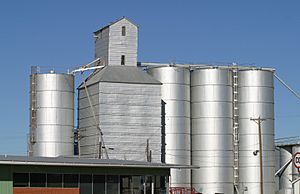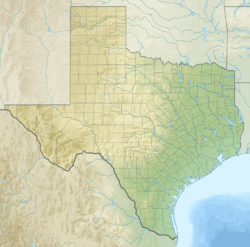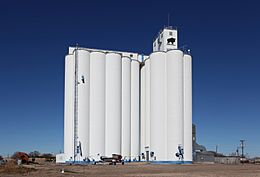Petersburg, Texas facts for kids
Quick facts for kids
Petersburg, Texas
|
|
|---|---|
|
City
|
|

An old grain elevator in downtown Petersburg
|
|
| Country | |
| State | |
| County | Hale |
| Region | Llano Estacado |
| Established | 1891 |
| Founded by | Ed M. White |
| Area | |
| • Total | 0.81 sq mi (2.10 km2) |
| • Land | 0.81 sq mi (2.10 km2) |
| • Water | 0.00 sq mi (0.00 km2) |
| Elevation | 3,255 ft (992 m) |
| Population
(2020)
|
|
| • Total | 1,014 |
| • Density | 1,252/sq mi (482.9/km2) |
| Time zone | UTC-6 (CST) |
| ZIP code |
79250
|
| Area code | 806 |
| FIPS code | 48-56996 |
Petersburg is a city in Hale County, Texas, United States. As of the 2020 census, it had a population of 1,014.
History
Petersburg was founded in 1891 as a post office in southeast Hale County. It was named for Zack Peters and his wife, Margaret, who was the first postmistress. In 1902, Ed M. White established a store at the site of the present community, and moved the post office 5 miles (8 km) southwest into Hale County. Although the townsite was platted in 1909, its population remained below 100 until the Fort Worth and Denver Railway was built through town in 1928. Wheat and grain sorghum (milo) were the main crops in the area until cotton was first planted in 1905.
The town was incorporated with a population of 200 in 1927. Petersburg grew as a farming and rail-shipment center, and by 1949, it had 22 businesses and 500 people. By 1980, its population had grown to 1,633; businesses included the Wylie Manufacturing Company, the Hughes Trucking Company, and a weekly newspaper, the Post. The population dropped to 1,262 according to the 2000 census.
Geography
Petersburg is located on the High Plains of the Llano Estacado at 33°52′10″N 101°35′51″W / 33.86944°N 101.59750°W (33.8695249, –101.5973877), in southeastern Hale County. It is 27 miles (43 km) south of Plainview, the county seat, and 31 miles (50 km) northeast of Lubbock.
According to the United States Census Bureau, the city has a total area of 0.81 sq mi (2.1 km2), all of it land.
Demographics
| Historical population | |||
|---|---|---|---|
| Census | Pop. | %± | |
| 1930 | 548 | — | |
| 1940 | 496 | −9.5% | |
| 1950 | 777 | 56.7% | |
| 1960 | 1,400 | 80.2% | |
| 1970 | 1,300 | −7.1% | |
| 1980 | 1,633 | 25.6% | |
| 1990 | 1,292 | −20.9% | |
| 2000 | 1,262 | −2.3% | |
| 2010 | 1,202 | −4.8% | |
| 2020 | 1,014 | −15.6% | |
| U.S. Decennial Census | |||
2020 census
| Race | Number | Percentage |
|---|---|---|
| White (NH) | 279 | 27.51% |
| Black or African American (NH) | 4 | 0.39% |
| Native American or Alaska Native (NH) | 3 | 0.3% |
| Asian (NH) | 3 | 0.3% |
| Some Other Race (NH) | 2 | 0.2% |
| Mixed/Multi-Racial (NH) | 14 | 1.38% |
| Hispanic or Latino | 709 | 69.92% |
| Total | 1,014 |
As of the 2020 United States census, there were 1,014 people, 397 households, and 272 families residing in the city.
Education
The city is served by the Petersburg Independent School District, and is home to the Petersburg High School Buffaloes.
Notable people
- John Richard Fowler (1927–2007), a member and president of the Texas State Board of Pharmacy and practicing pharmacist in Memphis, Texas, graduated from high school in Petersburg
See also
 In Spanish: Petersburg (Texas) para niños
In Spanish: Petersburg (Texas) para niños



